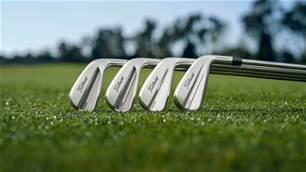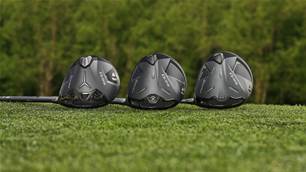I find there are few feelings like peeling the plastic off the face of a fresh set of irons. With that in mind, stepping up to trial the new Titleist T-Series immediately delivered a jolt of excitement.
From the T100 all the way to the pioneering T350, these irons look the part. At address the new T-Series carries off clean, compact shaping, with each model stepping up logically in size. The beauty of this progression is that the transitions between heads are deliberate and subtle, making set-blending straightforward. Each model looks like it belongs to a single family, with a restrained topline and sole that hints at forgiveness in the T250 and T350 without scaring off better players.
In practice the performance lives up to the looks. What struck me first was how stable the ball flight was across the family. The T100 played just as you’d expect a tour-level scoring iron to: moderate ball speeds, pinpoint accuracy, and a piercing, penetrating flight that crept through the air with minimal dispersion. The T150 then adds a touch more launch and speed while still keeping control. In other words, the T150 is slightly higher-launching and ball-fast, helping shots peak more and land steeper (great for holding firm greens) without feeling tamed. It quickly became my go-to mid-iron in the new set.
Moving up, the T250 really shows off its distance pedigree. This new model showed the biggest performance jump. Ball speed gains were immediate... Launch stayed playable and spin rates proved stable enough to prevent shots from running out. In my testing the T250 long irons absolutely leapt off the face; you feel the added pop. Yet the engineering on these clubs is unparalleled, Titleist have crafted them cleverly – the spin didn’t balloon out of control, and carry distances lifted noticeably (with predictable apex). Finally, the T350 proved the most powerful and forgiving of all. I was impressed by how effortlessly it launched the ball – the highest speeds of the group – and how well it shrugged off off-center strikes.

Despite these performance differences, the feel across the lineup is coherent. The forged T100 and T150 certainly feel softer and more responsive through impact, while the hollow-body T250 and T350 each feel a bit firmer and snappier – consistent with their construction. But none of them feel disconnected from Titleist’s trademark “solid through impact” identity. In fact, Titleist has tightened the performance gaps between the four models so that each does its job without feeling like a completely different club. Each iron does exactly what it’s meant to – precision with the T100, a bit more speed and height with the T150, genuine distance from the T250, and maximal launch/forgiveness with the T350 – all while sharing a consistent family DNA.
None of this happens by accident. Every new T-Series iron was engineered with specific goals, and the fitting process is integral. Even Titleist’s own materials emphasise that each iron is designed around specific performance characteristics, yet built to blend seamlessly in the bag. And behind the scenes, Titleist isn’t shy about how seriously it takes fitting, confidence in golf doesn’t just come from how you swing it. It comes from knowing your equipment has been tailored to you. Great clubs need great fitting to unlock their potential.

The 3Ds of Fitting
Titleist’s fitting philosophy boils down to the “3 Ds”: Distance control, Dispersion, and Descent angle. Even Titleist literature states that “Titleist’s 3 D’s – distance control, dispersion and angle of descent – guide both the fitting process and product development”. In practice, distance control is king. Titleist fitters will generally look for roughly a five-mile-per-hour ball-speed separation between successive irons – about a 10-metre carry gap. The goal is to achieve a consistent apex or peak carry height for each club. “We want to achieve that distance control. We want a consistent apex or peak height for the golf ball,” explains Titleist’s fitting leader Jonathan Law. Once a club is carrying to a precise yardage with the right launch, the next club in the bag should carry about 10m further, and so on.

Dispersion (especially side-to-side scatter) is largely dependent on the player’s swing, but Titleist fitters still try to minimise it via club configuration (lofts, MOI, lie, etc.). As Law says, east–west misses “are going to be golfer-related. If we can bring the distance control North-South in, then we know we’re getting some consistency”. In other words, nail the carry distance and apex first, and the spread of shots tends to fall into a tighter pattern.
The third D is descent angle – how steeply the ball lands. A steep landing helps shots hold greens instead of bouncing through. Titleist’s goal is often a landing (or “land angle”) of around 40° when possible. As their materials note, a steeper landing trajectory “helps the ball stop on greens rather than bouncing or running out”. This is why the new T-Series irons were designed to launch high (especially long irons) so that when combined with spin they descend sharply. In Law’s words, “our job as a fitting specialist is to get the ball to go as high as possible, realistically for that golfer, and then give them enough tools in their toolkit where they can get some distance separation with each club”. High launch plus tight gaps equals consistent scoring.

This rigour in fitting means blended sets are now the norm. Titleist flatly states, “every club in the bag has to earn its spot”. Instead of forcing one model from 4-iron through pitching wedge, the fitter might mix T100s and T150s in the short irons with T250s and T350s in the long irons, switching heads until the speed, height and gap numbers line up. You start by matching a 7-iron and 5-iron in one model to see if the numbers fit – and “if we don’t get the ball speed separation or we don’t get the height, then we move to the next chassis size”. The result is a set where every club is optimised.
 The overriding purpose, Law reminds us, is simple: the player should leave the fitting better than they came in. “We’ve got to make the player better than when they turned up for the fit, and we’ve got to give them a great experience,” he says. It’s about presenting the data, educating the golfer, and tailoring a set that inspires confidence.
The overriding purpose, Law reminds us, is simple: the player should leave the fitting better than they came in. “We’ve got to make the player better than when they turned up for the fit, and we’ve got to give them a great experience,” he says. It’s about presenting the data, educating the golfer, and tailoring a set that inspires confidence.
RIGHT: PHOTO: Thomas Creative.
If you’re curious about what a properly fitted T-Series set could do for your game, Titleist makes it easy to find out. New T-Series irons (T100, T150, T250, T250 Launch Spec and T350) are available now at Titleist’s fitting locations. You can book a custom iron-fitting at the Titleist website. Visit Titleist.com.au to find a fitting near you, and ensure your next set truly earns its place in your bag.
Related Articles

New Release: Titleist launches new T-Series iron lineup

Playing With... TaylorMade Qi35 Driver












